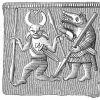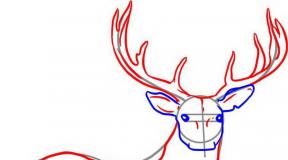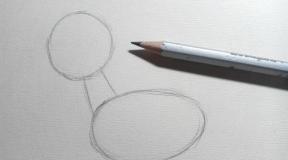Shark teeth. How many teeth does a shark have? Features of the structure of the jaw of a predator How often the teeth of a shark change
The shark, a bloodthirsty predator, a thunderstorm of the seas and oceans, attacks with lightning speed, knows no pity, is deadly. This short but true characterization applies to only three. Extremely fast and aggressive 4-meter mako shark, brown death. Large length 6-7 meters, the prototype of the monster in the movie "Jaws". And five meters long, the most fearless, capable of attacking even a whale. There are only three sharks from over 400 species. The rest of the sharks are less dangerous due to their slowness, not very aggressive and often just cowardly nature. However, if the shark is hungry, it becomes very dangerous. And if a shark suddenly smelled blood, it instantly wedges and it becomes a killing machine.
The most dangerous sharks are thermophilic, staying closer to the equator. Favorite habitats for the mako and tiger shark are the warm waters of the coastal zone. And the white shark feels great anywhere in the seas and oceans. Sharks, as representatives of the marine fauna, do not have a herd instinct and very rarely gather in schools. They prefer to hunt alone and only during the breeding season begin to communicate with each other. Millions of years of existence - such a long evolution once and for all determined the rules of life for a shark, and it will never become another.

The main and only weapon of a sea predator is teeth, or rather jaws with several rows of teeth. How many rows of teeth a shark has depends on its species. The load on the shark's teeth is unprecedented, it has to grab everything with its teeth indiscriminately, the teeth break, crumble and fall out. Therefore, nature took care of the predator, and the shark has a genetic mechanism for changing teeth. This process is fast, and depends on how many teeth a shark will have in the near future. Cyclic change of teeth about once every two weeks in young individuals and once every two months in old sharks. Moreover, new teeth do not grow in the place of those that have fallen out, but are already at the ready, pressing against the gums. The old teeth are gone, the new row is up and ready to go. Thus, a shark always has several rows of new teeth in stock, and the question of how many teeth a shark has is not an acute issue.

For example, a white shark and a tiger shark always have "mouth full of teeth." In each of 4-6 rows, bent back and pressed, there are up to 300 teeth. There have been several attempts to calculate how many teeth it turns out to have about 15 thousand. The shape of each tooth is also different for different sharks. Classic triangular in a white shark and complex teeth with small notches along the edges in a tiger shark. Some have teeth of an irregular, somewhat abstract shape. From the base to the tip, the tooth bends and becomes thin. Such a tooth will not bite into something hard, but if it clings to any flesh, it will be tight, it will not let go. There are usually fewer such teeth in the mouth of a shark, since they break less often. The task of such a victim's flesh is not to cut or chop it up.

Sometimes during the hunt, a shark has two or three rows of teeth, but only the front row is constantly involved, both on the top and on lower jaw... The jaws and teeth of sharks are a rather complex and at the same time well-oiled system. Nature has given bottom sharks, for example, smaller teeth, but with sharply sharpened edges to make it easier to bite through the shells of crabs and lobster, chitinous shells of crayfish and sea snails. But it is not known how many teeth a shark has, if it lives in the bottom zone, some have more, others have less. Sharks that swim in the upper layers of the body of water, feeding on seals and seals, have naturally long, curved, dagger-like teeth that pierce deep into the victim's body. And mother nature does not limit anyone in the number of teeth, and to the question of how many teeth a shark has, there is only one answer: "as much as you need."
If you don't feel like going to the dentist, you are not alone. Most people have concerns about visiting these specialists. One study from the Netherlands even showed that 24% of adults do not just dislike, but are afraid of dentists. In addition, a significant number of people try to avoid visiting such clinics and go there only in cases of emergency. This helps explain why 92% of adults have decay in their permanent teeth.
But there is good news. Recent studies show that we may soon have a chance to fill the cavities in our teeth with healthy living tissue, which will give our permanent teeth a second chance.
How shark teeth grow
It may seem that, in comparison with other species, people are very unlucky, since we have to be content with one set of teeth for the whole adult life... Shark lovers, for example, are familiar with the fact that these animals have unlimited sets of teeth throughout their lives. Some of them have a row of teeth under the skin that are just waiting in the wings to replace the missing ones. In addition, teeth are replaced every three weeks. That is why experts believe that the seabed is littered with shark teeth.
Complex structure
But if sharks, like most reptiles and amphibians, can replace their teeth during life, then why did humans and most mammals receive only two sets of teeth?
The fact is that there is a relationship between the complexity of the teeth and the number of sets that a species has. Since mammals have the ability to chew, they have complex sets of teeth. different shapes... For example, pointed canines have only one growth, while premolars have two, and molars have four or five. Such a complex structure of teeth depends on what the mammal feeds on. The species that eat bamboo, for example, have the most complex teeth. For example, the giant panda or bamboo lemur has complex rear teeth with many sharp tubercles that help chew and grind hard tissue. Thus, their teeth look the same even if they are not related to other mammals. 
How other animals restore teeth
There are other interesting examples of animals with the ability to repair their teeth. Piranha's teeth are fused together, and they resemble a very sharp knife. Therefore, piranhas lose not one tooth, but an entire quadrant, and they have to rely on the other three quadrants to survive until new ones grow.
Although mammals tend to have two sets of teeth, deciduous and permanent, some have retained the ability to develop more teeth. Manatees, for example, have the ability to develop teeth at the back of their mouth throughout their lives.
Other animals only got one set of teeth, but they are constantly growing. These are rodents such as mice or rats. The secret is that they have stem cells at the base of the tooth that promote dentin and enamel growth. This is necessary because of the solid food they eat. 
Evolution in action
It is unlikely that humans will ever develop the ability to have more than two sets of teeth, as evolution requires these differences to affect whether offspring can survive. Nevertheless, we are still developing in this regard - experts say that all less people now have wisdom teeth. These are third molars that appear in early adulthood, when our jaw is fully formed. This is because we have been preparing food for ourselves for a long time, and it is softer, so there is no need for third molars. In addition, our jaw is getting smaller, and, accordingly, there is no room for molars. That is why we see more and more people who do not have third molars. Only about 20% of the population does not have wisdom teeth. 
The first attempts of scientists
Perhaps we will never have a third set of teeth, but this does not stop scientists from trying to find a way to replace the extracted teeth with new ones, and, moreover, alive. A laboratory at King's College London has successfully implanted bio-teeth in mice. The scientists used human gum tissue and mouse stem cells to grow new teeth from dentin and enamel. One of the problems of using therapy in the human body is that the cultivation of stem cells takes place in a test tube, but there they quickly lose their power.
Nevertheless, science in this matter does not stand still, new methods of growing teeth appear, for which pulp tissue is used, for example, so it is quite possible that after a while new teeth will become available to ordinary people.
It may seem that, in comparison with other animals, man is very unlucky to have the same set of permanent teeth throughout most of his life.
Those interested in sharks know that their teeth grow all their lives. Moreover, in the mouth of these animals there is a spare row of teeth under the skin, which allows you to quickly make up for the loss of your main weapon.
It is also interesting that these predators change their teeth every three weeks, so, as scientists suggest, the ocean floor is literally littered with shark teeth.
So why, if in sharks, as well as in many reptiles and amphibians, teeth can grow an unlimited number of times, in humans they are replaced only once?
Abigail Tucker, professor of development and evolution at King's College London, says there is an inverse relationship between the complexity of teeth and their ability to regrow.
Since mammals can chew, that is, grind food, moving their jaws from side to side (this is especially noticeable in the example of the chewing movements of cows and horses), their teeth have a complex structure, and the shape of the teeth is determined by the presence of tubercles on them.
So, on the canines there is only one tubercle, on the premolars (small molars) - two, and on the molars (molars) - four or five tubercles.
“The complexity of the structure of the teeth is due to the diet. For example, animals that eat bamboo have the most complex teeth,” she says. solid food. Therefore, their teeth are similar, although they are completely different types. "
There are other interesting examples of animals with unusual tooth structures. So, piranhas' teeth grow together, forming something similar to a sharp knife. Therefore, they immediately lose a quarter of their teeth and use the remaining three, waiting until new teeth grow back.
In most mammals, teeth change only once in a lifetime - permanent ones grow in place of milk ones. However, some mammalian species retained (or redeveloped) the ability to regenerate teeth.
For example, in manatees, new ones grow in place of the lost back teeth throughout their life.
In other animals, the teeth never change at all, but instead they constantly grow. These are the Madagascar aye and some rodents, including rats and mice.
“Typically, rodents and rabbits have stem cells at the base of the tooth that form dentin (the hard tissue inside the tooth) and enamel. This is how they adapted to eat solid food,” says Tucker.
It is unlikely that humans will ever grow back lost teeth, after all, as it is believed, in the process of evolution, only those abilities appear that affect the survival of the offspring.
However, this does not mean that our development has stopped. Experts believe that people have less and less wisdom teeth - third molars that grow in youth, when our jaw is already fully formed.
"We cook food [cooking and other processing] and it softens, so we don't need third molars. Plus, our jaws get smaller, so they [wisdom teeth] just don't have enough room," says Tucker.
"Because of this, the number of people without third molars is constantly growing. About 20% of the population do not have wisdom teeth," she explains.
Perhaps the moment when people start to grow new ones in place of the lost teeth will never come, but this did not stop scientists from trying to find a way to replace the lost teeth with living tissue.
In one of the laboratories of King's College London, an experiment was successfully carried out on the implantation of bio-teeth in mice. Using cells from human gum tissue and cells responsible for the formation of teeth in mice, they were able to grow teeth with dentin and enamel in mice.
"Incredibly, scientists today can already implant this tooth embryo into the gum, and it will independently form a system around itself. blood vessels from the tissues surrounding it. This gives us a complete tooth with a living root, "says Tucker.
However, the difficulty of using this method in treating people, she said, is due to the fact that stem cells grown in a test tube are often not viable.
Another recently developed approach is based on the ability of a tooth to heal itself.
Ruchi Sahota, a California dentist and spokesman for the American Dental Association, compares a tooth to an apple.
“As the apple is covered with the skin, the tooth is covered with a thin layer of enamel that protects what is inside - the hard tissue. And the nerves inside our teeth can be compared to apple seeds,” she says.
"As a rule, caries begins with the enamel, and when it penetrates into the dentin, then it's time to put a filling. And if it gets to the nerve, then the root canal will have to be filled as well," she says.
Reminova is already working to bring new technology to market, also based on research from scientists at King's College London.
It consists in using electric current to remineralize tooth enamel at the first signs of caries. The procedure is completely painless.
There are other technologies available to treat caries that have already penetrated dentin.
To fill such cavities, it is proposed to use cells inside the tooth, which contribute to the formation of dentin, a calcified tissue that makes up the main part of the tooth.
A recent study published in the journal Science Translational Medicine, for example, showed that the effects of a laser with low level power on the exposed pulp of rat teeth before filling the cavity can stimulate the growth of stem cells from which dentin is subsequently formed.
Researchers at Nottingham and Harvard Universities are developing a biomaterial for the treatment of teeth, which will help to avoid root canal filling.
This material is able to stimulate the interaction between stem cells in the pulp with another material, resulting in the formation of a new type of cells capable of producing dentin.
"This material is applied to the pulp, and when exposed to ultraviolet rays, it solidifies into a plastic mass," says Adam Seliz, a PhD researcher who is developing the new technology.
"The native cells of the tooth interact with this mass and turn into other cells capable of producing dentin. We hope to restore the dentin layer so that the tooth becomes viable again so that the pulp does not have to be removed from the canal."
Of course, any dentist will tell you that the most important thing for dental health is caries prevention. To do this, you must observe oral hygiene and do not forget about regular visits to the dentist and proper nutrition.
“Remember that water is the most important thing for caries prevention, especially fluoridated water,” says Sakhota.
"Fluoride helps mineralize and regenerate dental tissue that can cause tooth decay, while water washes away food debris, bacteria and any debris that might get stuck in your teeth," she explains.
She adds that dairy products are also good for teeth, as they are rich in calcium, and that lean protein helps to strengthen and repair enamel.
But even if we get the opportunity to restore teeth, we should still refrain from eating refined sugar - one of the most dangerous components in the diet of a modern person.
By breaking down sugar, bacteria in the mouth release acid, which can cause tooth decay.
So which sweets should you avoid first? Lollipops, including candy on a stick, are the most dangerous, Sahota says, because you are constantly in contact with sugar when you eat them.
Gummies are also harmful, she says, as they can get stuck in your teeth for a long time.
However, she has good news for chocolate lovers. "A piece of chocolate after lunch or dinner is much better than many other sweets because it is easier to remove from the mouth. Therefore, I recommend it as a dessert."
Among the many questions that the viewer has when viewing photographs of sharks, one especially stands out - how many teeth does a shark have?
Fanged mouths of sea predators different types demonstrate many white and sharp teeth, among them there is not a single damaged one - is this possible, because even sea turtles with their strong horny shells become objects of shark hunting!
The fact is that the teeth of sharks are not only in the mouth - figuratively speaking, their entire body is covered with teeth. In sharks, in the form of a plate, ending in a tooth, the point of which is directed to the caudal fin of the predator.
For this reason, touching the shark's body is possible only with steel chain-mail gloves, otherwise serious damage to the skin cannot be avoided.
Watch the video - Shark teeth:
How many teeth does a shark have?
Millions of years of evolution have done their job, leaving the ocean predator best weapon- the number of teeth of a shark is practically unlimited, because they grow all its life.
As a rule, in the mouth of each shark, the teeth are lined up in 3-20 rows on each jaw and in each row there are at least 30 of them. In an adult, the total number is from 200 to 15,000 units.
The number of teeth a shark has depends on its species:
Ridge-toothed sharks have 6 rows of teeth on the lower and 4 rows on the upper jaws with a total of 180-220 teeth.
The number of teeth in a shark is no joke, and to reduce the risk of damage to the inner surface of its own mouth, the farthest rows of teeth are tilted inward, facilitating the advancement of prey into the stomach.
There is an important reason why the superorder of sharks requires such teeth - not rooted and quickly replaceable. The design differs from the device of the respiratory organs of other ocean inhabitants: in order to breathe, the shark must always move, and do this with its mouth constantly open.
If the shark cannot swim forward or its mouth is occupied by the body of the victim, the shark will drown and suffocate. For this reason, molars stuck in the flesh of the hunted object would create serious problems for the predator - but this will not happen if the teeth are easy to fall off.
The following happens - if a shark comes across a large prey, it can always release it from its mouth, discarding the teeth that have gotten stuck in the process and clinging to the prey again.
Killer Shark Teeth - Right From Birth:
All power is in the teeth!
Each shark species is armed with the number of teeth that it needs to survive. For 10 years of life, sharks of large species change about 24 thousand teeth!
Interestingly, in shark embryos, it mutates just before the shark is born.
The number of teeth in a newborn shark is almost identical to the number of teeth in its older relatives - teeth are essential for hunting, speedy growth and gaining muscle mass: in the ocean community, everything is very simple - whoever grows faster has a better chance of surviving.
By the way, teeth are all that remains after the death of a shark. Its body does not contain bones, only cartilage, so it is completely eaten by bottom scavengers, and what is not eaten is decomposed without residue.
Now on the Internet you can find any information, video in a minute, and before everything Interesting Facts I learned from educational programs on TV. I remember there was a channel where they were telling a lot of interesting things about the animal world all day long. I remember very much the eerie shots with sharks, their huge jaws with hundreds of teeth... When we went to the sea with my parents as a child, I was even a little afraid to go into the water, it seemed to me that a shark fin was about to appear. Are sharks really as dangerous as we used to think?
Shark teeth and their features
The open mouth of a shark with a huge number of teeth looks very intimidating. Really, shark is one of the most toothy creatures in the world... The point here is not in their number, although some species of sharks have thousands of teeth, but in the fact that sharks are able to renew them about once a week.

Shark's teeth are arranged in a special way. This is necessary so that her prey could not escape from her mouth in any way. The teeth are arranged in several even rows... Each tooth is directed inward, due to which the shark grips its prey very tightly. Each row may contain about 1000 of these teeth... You will not envy someone who falls into her mouth.
The most toothy shark
There are many types of sharks, and depending on this, each representative has a different number of teeth. The first lines of the rating of sharks with the largest number of teeth are occupied by:
- Whale shark.
- Bigmouth shark.
- Giant shark.
- Reef shark.
- Sand tiger shark.

Whale shark surprises not only with its size, but also with the number of teeth that are hidden in its mouth. It was she is in the first place in terms of their number among all akul... Its length can be 15-20 meters, and the weight of this giant fish can reach 20 tons. How many teeth do you think a shark has with this size? In the mouth of this huge shark, you can count up to 15,000 teeth. All of them are built in rows, of which there are approximately 18-20 pieces on each jaw. Impressive? Yeah, it looks very scary. But in fact, with such a huge size and number of teeth, this shark feeds on plankton, various small fish and does not pose a danger to humans... She almost never swims to the shore. She behaves calmly. Some avid scuba divers even had the opportunity to swim very close to the whale shark, take a few photos and even touch this giant creature.



















